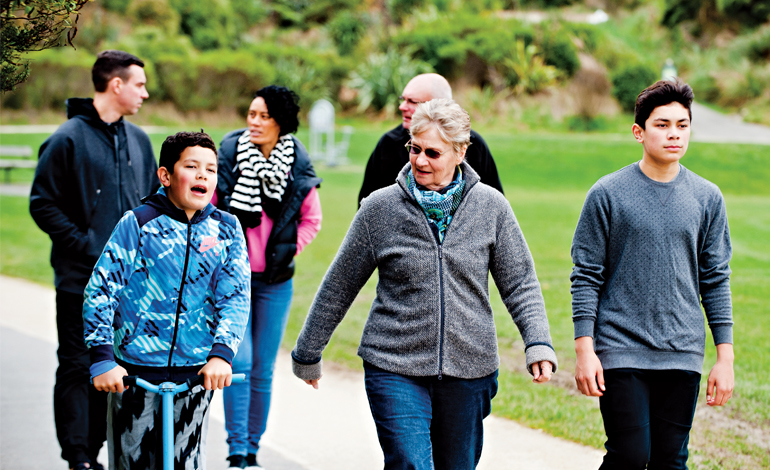Hamilton and New Plymouth lead the charge
Help for councils
The Office for Seniors has released an online toolkit to help councils and community groups start their own age-friendly journeys.
The Community Connects grants also offer funding to start development of an Age-friendly Communities Plan or implement an Age-friendly Community project.For more information go to superseniors.msd.govt.nz
By 2038, an estimated 1.3 million New Zealanders will be aged 65 and over. All levels of government are facing the issue of an ageing population. Some local councils are turning to a model from the World Health Organization to help them become more age-friendly.
A World Health Organization (WHO) age-friendly model promotes changes to infrastructure, services and attitudes to allow older people to access the services they need and to engage with their families, friends and the wider community as they age.
It has already been adopted globally by over 800 cities in around 40 countries including Australia, the UK, the US and Canada.
It is growing at home as well. In June 2018, New Zealand was accepted as an affiliate member of the WHO Global Network of Age-friendly Cities and Communities.
Hamilton and New Plymouth have been included in the network and Palmerston North, Auckland and Nelson councils have also indicated they are working to join the global network.
Hamilton was the first New Zealand city to join the network in May 2018.
The idea originated from the Hamilton City Council Older Peoples Advisory Group and was supported by a group from the community.
Hamilton City Council community development team leader of planning and policy Nick Chester said one of the first lessons they learnt was to make the most of what they had.
With a limited budget they built strong relationships with community groups who took on their own projects that they funded themselves.
They also took a stocktake of what services they already offered – with unexpected results.
“We realised there was a huge amount out there and one of the biggest things we could do was highlight them so older people knew about them and other agencies were linked to each other,” he says.
“It sounds really simple but a lot of the different groups just didn’t know about each other. It was unexpected that we would get some gains just by simply putting people together.”
The importance of older Maori also played a significant part in the plan thanks to input from the Rauawaawa Kaumatua Charitable Trust.
“It’s really important not to overlook this as things are being developed,” says Nick.
“It’s a real point of difference that we can have as the New Zealand plan starts to get developed. We should really be talking about our older Maori in the community and what role they have to play.”
Dame Peggy Koopman-Boyden has been a long-time advocate for older people and has been researching the issue for more than 30 years.
She chaired the Age Friendly Hamilton Steering Group and said the need for a new model was obvious.
“The world has never had so many people who lived so long. This is something new and we need everybody we can get with their ideas.”
She says it was important to be realistic about what was manageable and what could be successful.
Instead of trying to solve the entire issue of housing on their own they have instead focused on smaller, more specific projects including publicising the Good Homes Repairs and Maintenance Manual and expanding the number of Kaumatua villages in Hamilton.
Hamilton released its age-friendly plan in July 2018 with 48 action items.
It has already ticked off several items – a highlight being the 50+ and Loving It festival in April 2018.
New Plymouth was the second New Zealand city to join in January.
It was an idea born more than four years ago and was led by Positive Ageing Taranaki.
Chair Lance Girling-Butcher says their acceptance into the network relied on a dedicated steering group and strong networks within the local council.
“You need to have that sort of support,” he says.
“It’s getting those elected people to realise that while it is really important to do your basics – like your roads and your pipes and your sewage and water – there is a community side to all this. You can have the best facilities in the world but if you haven’t got a happy population, you’ve lost the battle.
“There’s the thought of older people being in the minority but 17 percent of the population is over 65 and that will nearly double by 2050.”
An action plan is being developed but already the group is seeing a positive reaction from the community.
A daily bus service is now running between Hawera and New Plymouth. And there are talks to establish in Taranaki an Abbeyfield House providing shared, affordable accommodation for older people in the area.
This article was first published in the April 2019 issue of NZ Local Government Magazine.

